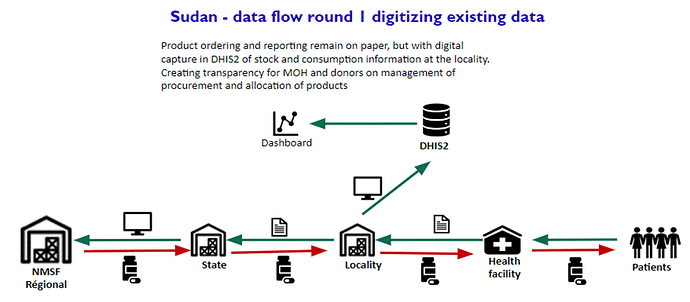Context
The background for this project is a planned process and engagement between the Federal Ministry of Health of Sudan (FMOH), HISP Rwanda and University of Oslo to enhance Sudan Logistics management by bridging last mile data with the National central LMIS system as part of a larger health system strengthening initiative supported by The Global Fund. This work included consultations in Sudan and development of documentation of both the existing LMIS reporting and how it could be digitised and improved.
The principle of the plan is to work in three rounds and designed in a way that each round can be implemented independently, and with the completion of each individual round on its own giving an additional significant strengthening of the product management in Sudan. Every round adds value and every round will bring the country forward and strengthen the management of logistics of supplies. The final objective of this project is to secure a flow of LMIS information that can ensure timely supplies of all products to health facilities in Sudan. This phased approach was specifically developed to ensure a successful implementation not hindered by the incident that began in April 2023 in Sudan that resulted in insecurities in some states.
Objective
The Round One objective was to digitally aggregate the LMIS information already collected in paper forms for HIV, TB and Malaria and make this information immediately available in a digital dashboard. This dashboard shall then be used for management of the supplies at both the locality level and the national level. The solution is utilising DHIS2 Open source system that is technologically simple and has worked for a number of years in other countries during the period of the security issues.
Achievements/results
The initial plan/work was interrupted by the April 2023 incident in Sudan, but revitalised in mid-2023. We have now succeeded in implementing the first round, configuring the system, training, implementing and rolling it out to 38% (71/189) of the localities in Sudan, covering 47% (3,300/7,000) of health facilities and 41% (18.8 million/ 45.5 million) of Sudan’s population. Under Round One, we have within 3 months configured the system and trained 174 Sudanese in entering the existing paper based LMIS forms into a DHIS2 screen at locality level. Thereby aggregating the paper-based information and making it immediately available at both National and Locality level for management purposes.
The plan and budget for implementation of this round one was compressed in order to make it possible to implement it very quickly and seamlessly utilising in-country personnel, stakeholders at Federal Ministry of Health, NGO’s (Global Fund) and virtual support from UiO and HISP Rwanda experts. The insecurity crisis in Sudan heightened the benefits and urgent needs to obtain stock data for management of the product supply. It builds on the fact that a number of needed resources and infrastructure necessary were already in place.
The solution provided at the end of round one followed this architecture:
Challenges & Constraints
The main challenge during the project implementation was the ongoing insecurity in Sudan that limited field visits and shake of existing resources and infrastructure. The HMIS/DHIS2 instance was moved from a government data centre based in Khartoum to a cloud-based solution, in order to continue operation. However, much of the regular reporting activities were understandably reduced as staff prioritised their day-to-day needs. The Sudan country teams in FMoH and Global Fund PMU advocated for continuing the implementation with the reduced scope, as it would help strengthen the health services in areas not directly affected by the conflict. The continued challenge to be expected will be to support the HMIS and supply chain teams reporting, particularly at facility level, if the insecurity persists.
Conclusion/ Way forward
While the round one is providing an immediate monthly overview of supply situation across health facilities for 8 states for HIV, TB and Malaria, the intention is to move to round two that will provide a monthly overview of “end to end” supply situation through integrating DHIS2 with National Medical Supplies Fund (NMSF) Enterprise Resource Planning (ERP), including central stocks for all the 18 states, covering all health programs including essential medicines. In Round three, the objective will be to provide real-time overview of supply situation “end to end” and manage products digitally at health facility level across Sudan by implementing DHIS2 Real Time Stock Management Tool.
